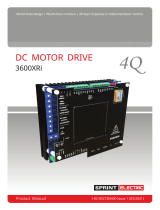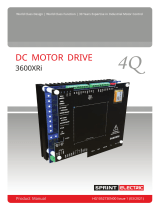
English (GB)
10
11
Motor thermistor
overtemp
The thermistor or the thermistor connection is
disconnected. Select whether the adjustable
frequency drive should give a warning or an alarm
when the counter reaches 100 % in parameter 1-90
Motor Thermal Protection.
• Check if the motor is overheating.
• Check if the motor is mechanically
overloaded.
• Make sure that the thermistor is
connected correctly between terminal 53
or 54 (analog voltage input) and terminal
50 (+10 V supply), or between terminal 18
or 19 (digital input PNP only) and terminal
50.
• If a KTY sensor is used, check for correct
connection between terminal 54 and 55.
• If using a thermal switch or thermistor,
check the programming of parameter 1-93
matches sensor wiring.
• If using a KTY sensor, check the
programming of parameters 1-95, 1-96,
and 1-97 match sensor wiring.
W/A
12 Torque limit
The torque is higher than the value in parameter "4-
16 Torque Limit Motor Mode" (in motor operation),
or the torque is higher than the value in parameter
"4-17 Torque Limit Generator Mode" (in
regenerative operation).
Parameter 14-25 can be used to change this
from a warning only condition to a warning
followed by an alarm.
W/A
13 Overcurrent
The inverter peak current limit, approx. 200 % of the
rated current, is exceeded. The warning lasts about
1.5 sec. Then the adjustable frequency drive trips
and issues an alarm. If extended mechanical brake
control is selected, trip can be reset externally.
• Remove the power from the drive.
• Check that the motor shaft can be turned.
• Check that the motor size matches the
drive.
• Check that the motor data is set correctly
in parameters 1-20 to 1-25.
W/A
14 Earth fault
There is a discharge from the output phases to
earth, either in the cable between the adjustable
frequency drive and the motor or in the motor itself.
Turn off the adjustable frequency drive and
remove the earth fault.
Measure the resistance to earth of the motor
leads and the motor with a megohmmeter to
check for earth faults in the motor.
Perform current sensor test.
A
15
Hardware
mismatch
A fitted option is not operational with the present
control board hardware or software.
Record the value of the following parameters and
contact Grundfos:
15-40 FC Type
15-41 Power Section
15-42 Voltage
15-43 Software Version
15-45 Actual Type code String
15-49 SW ID Control Card
15-50 SW ID Power Card
15-60 Option Mounted (for each option slot)
15-61 Option SW Version (for each option slot)
Contact Grundfos Service. A
16 Short circuit
There is short-circuiting in the motor or on the motor
terminals.
Turn off the adjustable frequency drive and
remove the short circuit.
A
17
Control word
timeout
There is no communication to the adjustable
frequency drive.
The warning will only be active when parameter 8-
04 Control Word Timeout Function is NOT set to
OFF.
If parameter 8-04 Control Word Timeout Function is
set to Stop and Trip, a warning appears and the
adjustable frequency drive ramps down until it trips,
while giving an alarm.
Check the connections on the serial
communication cable.
Increase parameter 8-03 Control Word
Timeout Time.
Check the operation of the communication
equipment.
Verify proper installation based on EMC
requirements.
W/A
18 Start failed
The speed has not been able to exceed parameter
1-77 Compressor Start Max Speed [RPM] during
start within the allowed time that was set in
parameter 1-79 Compressor Start Max Time to Trip.
Check that motor is not blocked. A
21 Parameter error
The parameter is out of range. The parameter
number is shown on the operating panel.
Set the affected parameter to a valid value. W/A
23 Internal fan fault
The fan warning function is an extra protection
function that checks if the fan is running/mounted.
The fan warning can be disabled in parameter 14-53
Fan Monitor ([0] Disabled).
For the D, E, and F Frame drives, the regulated
voltage to the fans is monitored.
Check fan resistance.
Check soft charge fuses.
W
Alarm
code
Description Cause Remedy Type
























